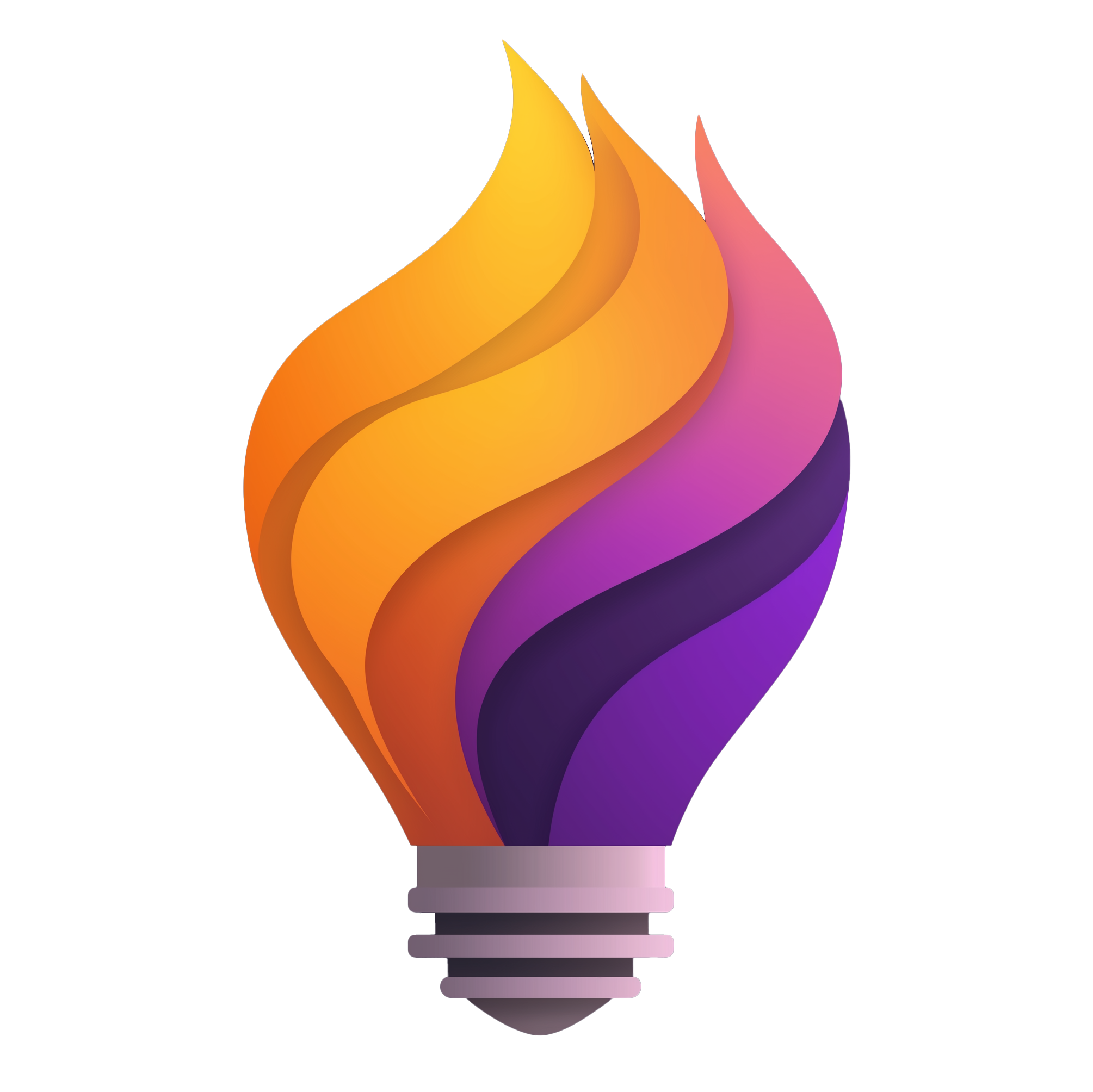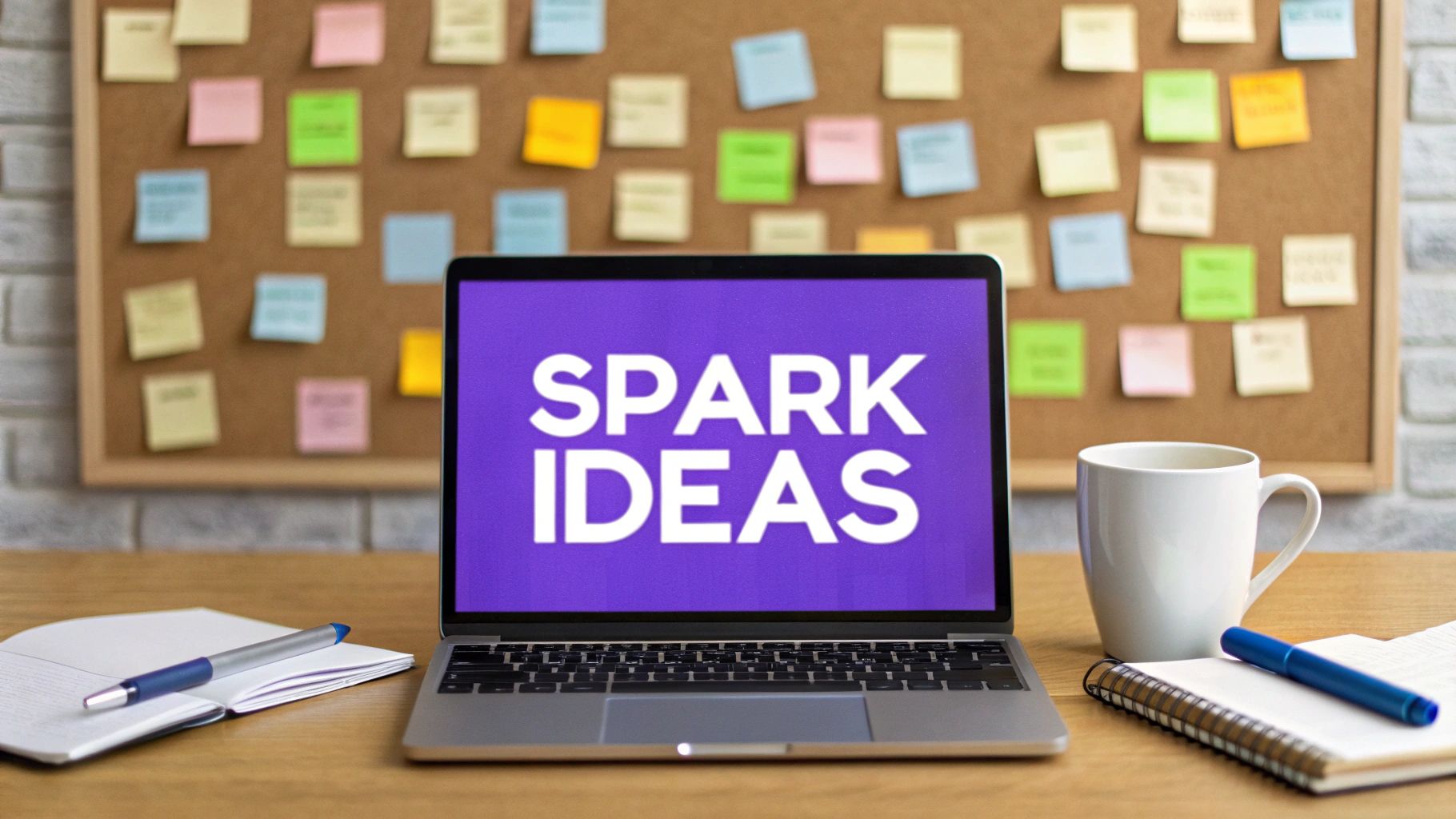Ever found yourself staring at a screen of silent, uninspired faces during a remote brainstorm? You're not alone. The problem often isn't a lack of creativity—it's the questions we're asking. Closed questions are conversation killers, but the right open-ended question can unlock a flood of exploration, psychological safety, and genuine innovation.
How Open-Ended Questions Spark Creative Breakthroughs
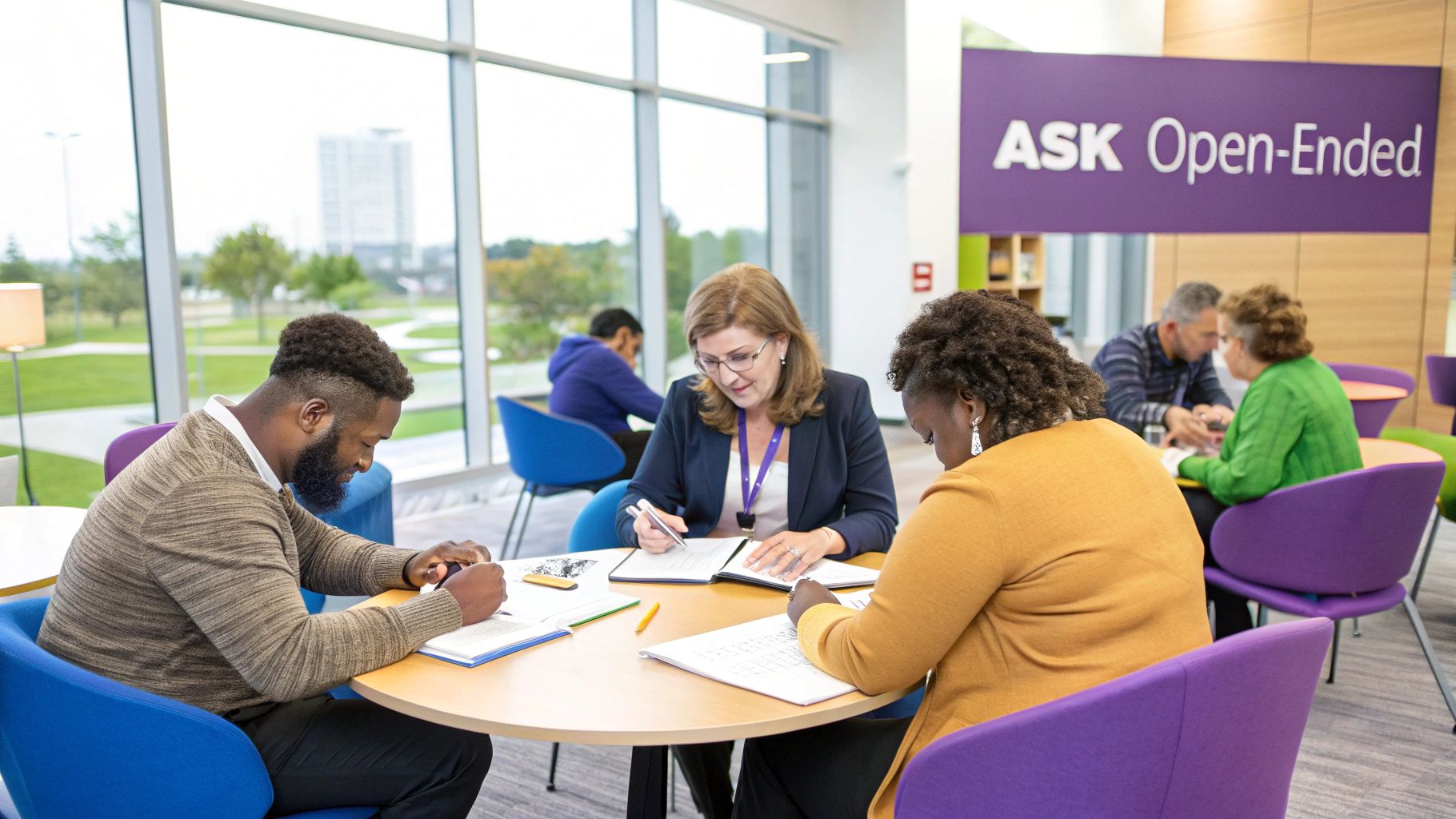
Let's walk through a real-world scenario. A design team is in a slump. The facilitator kicks things off by asking, "Do you like this new mockup?" A few people quietly agree, but the energy is completely flat. Why? Because the question only asked for a simple "yes" or "no," effectively slamming the door on any deeper thinking.
Now, imagine the facilitator reframes the question: "Walk me through what this mockup makes you feel about our customer's journey." The entire dynamic shifts. One person immediately points out a potential friction point. Another starts sketching an alternative user flow, and a third gets an idea for a whole new feature. That's the power of an open-ended question.
Getting Past "Yes" or "No"
Closed questions are designed for specific, often one-word answers. They're great for confirming facts ("Did the client approve the wireframe?"), but they’re poison for a creative session.
Open-ended questions, on the other hand, are conversational invitations. They act as prompts, asking for stories, opinions, and detailed thoughts. They usually start with words that get people talking:
- How… ("How might we see this from a completely different angle?")
- What… ("What other possibilities does this idea bring to mind?")
- Why… ("Why do you think users reacted that way in the test?")
This small change in language completely transforms the conversation. It tells your team that their unique perspective isn't just welcome—it's essential. The goal shifts from finding the single right answer to exploring all the interesting answers.
When you ask for narratives instead of affirmations, you create an environment where creativity thrives. You're not just collecting data; you're building a shared understanding and digging up insights that were buried just below the surface.
Building a Safe Space for Bold Ideas
In a remote environment, building psychological safety is absolutely critical. People need to feel safe enough to share those half-baked or "wild" ideas without fear of judgment. Closed questions can feel like a pop quiz, making people hesitant to speak up unless they're 100% certain.
Open-ended questions tear down that barrier.
When you ask something like, "What's one unconventional way we could tackle this?" there's no such thing as a wrong answer. This approach encourages vulnerability and builds trust, which in turn leads to more authentic and groundbreaking ideas. The brainstorming process itself becomes a powerful way to https://www.remotesparks.com/how-to-boost-creativity/ by making exploration the default setting for your team.
Once those initial sparks start flying, you can use modern tools to bring them to life. For example, AI-powered creative tools like MagicPatterns can help you rapidly visualize and iterate on those fledgling concepts. It's this blend of thoughtful questioning and the right tech that turns a dull meeting into an engine for real innovation.
Crafting Questions That Invite Deeper Thinking
Let's get practical. Moving beyond theory means rolling up our sleeves and actually building powerful questions. We've all seen generic prompts fall flat, but the architecture of an effective question is a skill anyone can learn. It all starts with intentional phrasing that opens doors instead of slamming them shut.
Simple starters like "How might we…" or "What if…" are more than just words; they're signals. They tell your team that you value their detailed thoughts and want to explore possibilities, not just get a quick answer. The goal is to turn a limiting query into an expansive exploration that sparks genuine curiosity.
This subtle shift is everything when you're trying to fuel a creative session.
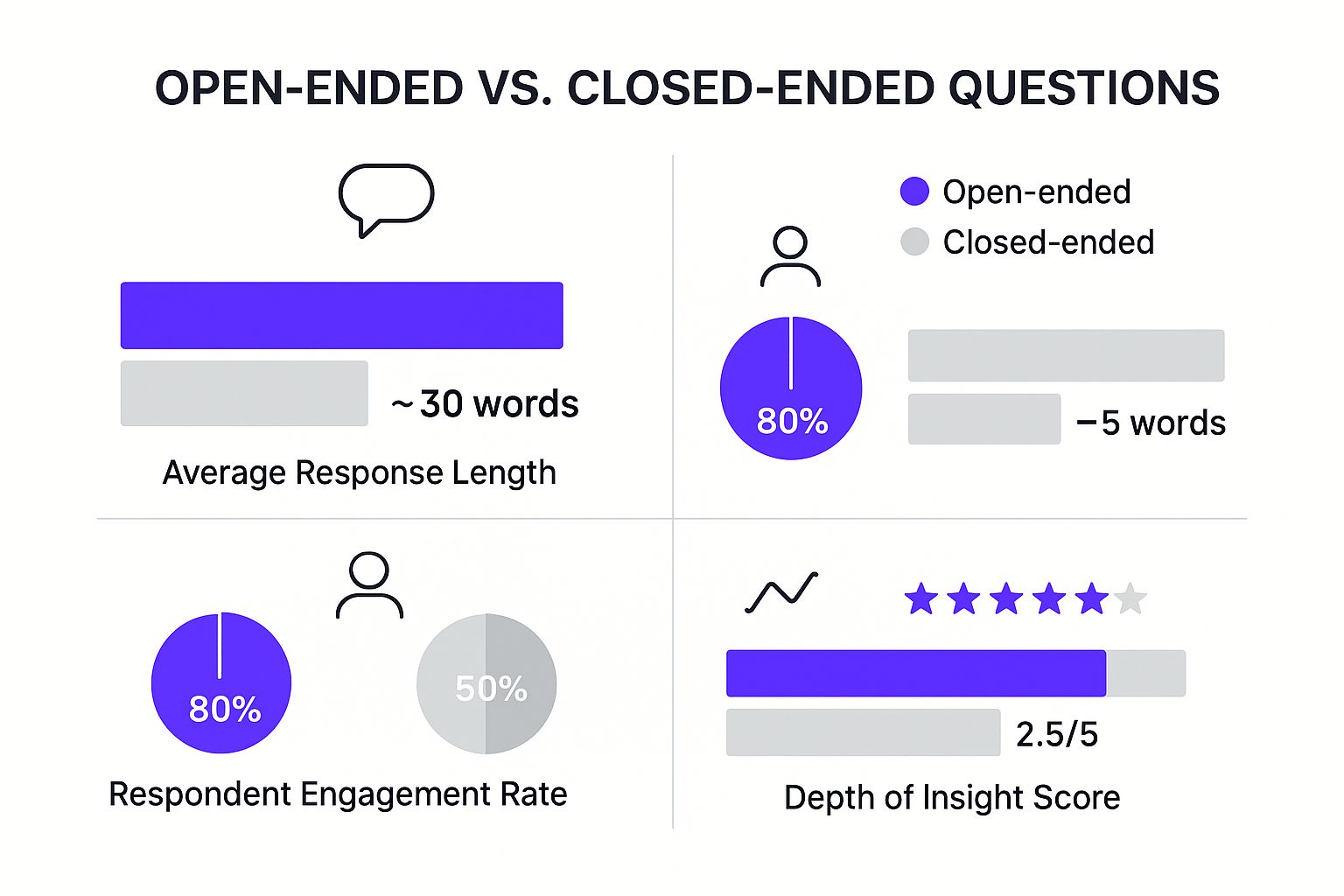
The image above really drives this point home. While closed questions get you quick, surface-level answers, it's the open-ended ones that unlock longer, more engaged, and far more insightful responses.
Reframe Your Questions for Better Insights
The real art lies in reframing. I've found that almost any question seeking a simple "yes" or "no" can be flipped into one that invites a world of new possibilities. The trick is to shift the focus from a binary decision ("Should we do this?") to the conditions for success ("What would need to be true for this to work?").
Here’s what this looks like in the real world:
- Marketing: Instead of asking, "Should we target Gen Z?" try this: "What would need to be true for Gen Z to become our biggest brand advocates?" This immediately elevates the conversation from a simple vote to a strategic discussion about opportunities and roadblocks.
- Product Development: A question like, "Do you think users will like this feature?" is a dead end. Ask this instead: "Walk me through how this new feature might change a user's daily workflow." This encourages storytelling and often reveals use cases you never even considered.
- Process Improvement: Ditch the lazy, "Is our current onboarding process good?" Ask your team: "If you could redesign our onboarding process from scratch with no limitations, what would you prioritize?" This frees everyone to think beyond small tweaks and envision an ideal state.
This isn't just about semantics. It's about changing the fundamental goal of your question from seeking confirmation to sparking genuine exploration. For more real-world examples, you can find a ton of inspiration here: https://www.remotesparks.com/open-ended-questions-examples/
Transforming Closed Questions into Open Explorations
It's one thing to talk about this in theory, but seeing the transformation side-by-side makes it click. Here’s a quick-glance table showing how to convert common discussion-killers into conversation-starters.
| Closed Question (Limits Discussion) | Open Ended Alternative (Sparks Creativity) | Intended Outcome |
|---|---|---|
| Did you like the new design? | What are your first impressions of this new design? | Gather unbiased, initial reactions and detailed feedback. |
| Can we meet the deadline? | What potential obstacles might prevent us from meeting the deadline? | Proactively identify risks and brainstorm solutions. |
| Should we use this marketing channel? | How might this marketing channel help us reach a new audience? | Explore strategic potential instead of a simple yes/no. |
| Is the new software update ready? | What feedback have we received during testing, and what remains to be done? | Get a comprehensive status update, not just a confirmation. |
Flipping the script like this encourages your team to think critically and provide the kind of rich, detailed insights that actually move a project forward.
Spotting and Removing Hidden Bias
Here's something I learned the hard way: even our best-intentioned questions can be loaded with hidden biases that steer people toward a certain answer. For example, asking, "How can we make this flawed design better?" immediately frames the design as a failure and narrows the scope of feedback. A much cleaner, more neutral question is, "What are your initial impressions of this design?"
The way you structure a question can completely change the answers you get, often revealing insights you never anticipated. A famous Pew Research poll found that when asked about the most important issue in an election, 58% of people chose "the economy" from a pre-selected list. But when asked the same question in an open-ended format, only 35% mentioned it on their own.
To make sure your questions are truly opening doors, it helps to incorporate some essential instructional design best practices. The core idea is to structure prompts that genuinely encourage discovery rather than leading people down a path.
Before your next brainstorming session, run your questions through this quick audit:
- Does my question assume a specific outcome or emotion?
- Am I using neutral language that avoids judgment?
- Could my question be answered with a simple "yes" or "no"?
- Does it invite multiple perspectives rather than one "correct" answer?
By consciously filtering your questions through this lens, you create a much more neutral and inviting space for genuine brainstorming. It’s how you get to the unexpected—and often most valuable—ideas.
Keeping the Brainstorming Session on Track
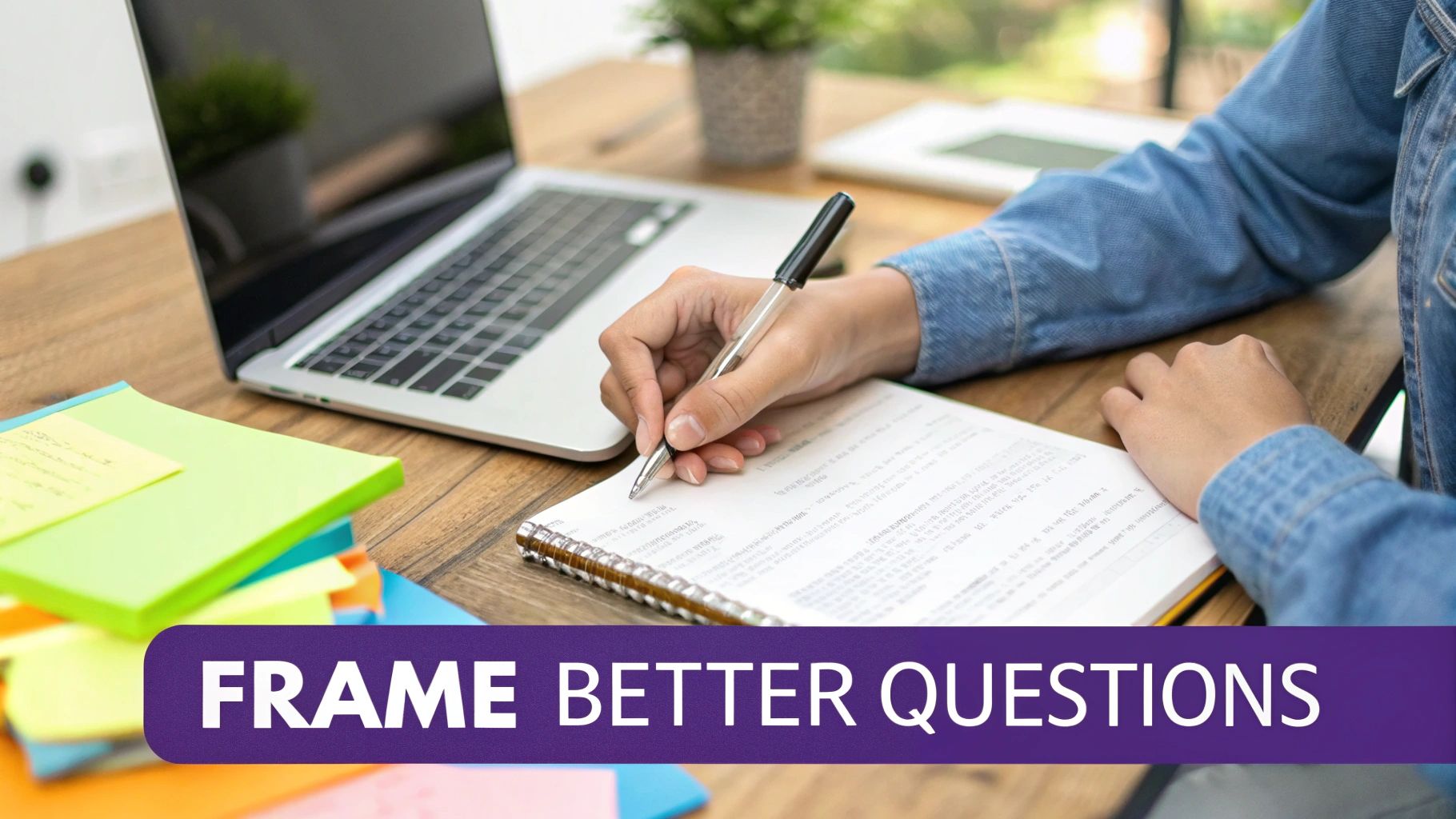
This is where the rubber meets the road. You can have the most brilliant, thought-provoking questions, but they won't do you much good if the session itself is a mess. A successful remote brainstorm needs a solid structure and a facilitator who can keep the energy up and the ideas coming.
A great first step is to share the main open-ended question before the meeting even starts. This gives everyone a chance to mull it over on their own time. You'll find this is a game-changer for introverted team members, who often do their best thinking before they have to speak up.
Create a Structure for Success
Let's be honest, remote meetings can easily get derailed. Without a clear plan, you'll often have one or two people dominating the conversation while everyone else tunes out. As the facilitator, your job is to build a framework that gives everyone a real chance to share their thoughts.
Here are a couple of my favorite, battle-tested methods:
-
Try a round-robin. After you pose the question, just go around the virtual room. Give each person an uninterrupted two minutes to get their initial ideas on the table. It's a simple trick, but it guarantees even the quietest voices are heard right from the start.
-
Start with silent brainstorming. Kick things off with five to seven minutes of quiet time. Have everyone add their ideas as sticky notes to a digital whiteboard like Miro or Mural. This approach separates the ideas from the personalities, letting the best thoughts rise to the top on their own merit.
Of course, there are plenty of other virtual brainstorming techniques out there. The key is to find what works for your specific team.
Keep the Momentum High
We've all been in those remote meetings where the energy just drains out of the room. It’s on you, the facilitator, to keep things moving. You're the session's pulse.
Pay attention to the digital whiteboard. When you see a bunch of similar ideas popping up, that's your cue to nudge the conversation in a new direction.
Use a quick follow-up question to shake things up:
- "Okay, these are all fantastic ideas for tweaking our current system. But what if we had to start from scratch?"
- "I'm seeing a lot of safe, practical solutions. That's great. Now, what's the wildest, most out-there idea we can think of?"
These little pivots are like a shot of creative espresso. They jolt the team out of a rut and get them looking at the problem from a completely different perspective.
Your role isn't to be the smartest person in the room. It's to ask the right questions at the right moments. Think of yourself as a guide, not a guru, helping the team find its own way to a brilliant solution.
When you mix a clear structure with active, thoughtful facilitation, a standard video call can become a real engine for creativity. It's how you make sure your awesome open-ended questions actually lead to equally awesome results.
Navigating Common Facilitation Challenges

We've all been there. You ask a brilliant, thought-provoking question, ready for the flood of ideas, and you get… silence. It’s one of the most common facilitation hurdles, but it's almost never a sign of a bad question. More often than not, it just means your team needs a second to think.
This is all about "response burden." Open-ended questions demand real cognitive energy, unlike simple yes-or-no prompts. It’s a well-documented effect in survey design. For instance, open-ended questions can have an item nonresponse rate of around 18%, while closed questions see only 1-2%. Why? Because they simply require more effort to answer. You can read more about this phenomenon from Pew Research Center.
So, what do you do with that silence? Embrace it. Count to ten in your head. That quiet pause is often where the best ideas are being formed. If the silence stretches on, just rephrase the question from a slightly different angle. Give them another door into the conversation.
Dealing With Vague Answers and Dominant Voices
Another classic challenge is the low-effort, surface-level response. Someone might toss out a vague idea like, "We need to be more innovative." That’s your cue to gently probe, without making them feel like they're on the spot.
My go-to technique for this is the "Five Whys." It’s a wonderfully simple way to get to the heart of an idea.
- Ask Why #1: "That's a great point. Why do you feel innovation is the most critical thing for us right now?"
- Ask Why #2: "And why is our current approach not hitting that mark?"
- Ask Why #3: "Why do you think that specific issue is holding us back the most?"
This simple layering encourages deeper, more concrete thinking.
On the flip side, you have the challenge of dominant personalities who might accidentally hog the spotlight. The best way I've found to manage this is by structuring the conversation. A simple round-robin, where you explicitly give each person the floor for a minute, ensures every voice is heard.
A facilitator's greatest skill isn't just asking the initial question; it's in the follow-up. Your ability to rephrase, redirect, and gently probe turns a good brainstorming session into a great one.
Keeping the Energy and Focus High
Remote meetings are notorious energy drains. As the facilitator, it's on you to keep the momentum going without exhausting everyone. If you notice the discussion starting to meander or see a few cameras-off participants zoning out, it's time for a pivot.
A gentle clarifying question can work wonders. Try something like, "That's an interesting tangent—how does that connect back to our core challenge of increasing user engagement?" This nudges the group back to the main topic without shutting anyone down. For a deeper dive into managing group dynamics, our guide on remote facilitation best practices has a ton of useful tips.
By thinking about these common roadblocks ahead of time—the silence, the vague answers, the dominant talkers, and the energy lulls—you can walk into your session prepared. This proactive mindset will give you the confidence to steer your team through anything, making sure your brainstorm stays creative and productive from start to finish.
Taking Your Brainstormed Ideas from 'Maybe' to 'Done'
A great brainstorming session leaves everyone feeling energized and full of possibility. But that energy can fade fast. If you don't have a plan to act on all those brilliant ideas you just generated, they'll likely vanish into thin air by the next morning. The real trick is building a solid bridge from that big, creative conversation to real, tangible results.
This is where a lot of teams get stuck—moving from broad, creative thinking to sharp, focused action. After a good session, you're essentially sitting on a pile of raw, qualitative gold. Much like researchers analyzing open-ended survey responses, the variety and depth of the ideas are a huge asset, but they can also be overwhelming. It takes a structured approach to sort through it all. You can see how research pros handle this kind of data in this overview of qualitative data analysis.
Create Order from the Chaos with Affinity Mapping
First things first, you need to make sense of everything you've gathered. A digital affinity mapping exercise is a fantastic way to do this. Get everyone on a virtual whiteboard, and have the team silently drag and drop related ideas (your virtual sticky notes) into clusters.
The point here isn't to judge or critique. It's simply about spotting patterns. As you group the notes, you'll start to see themes emerge naturally. Maybe a bunch of ideas are clustered around improving team communication, while another group is all about a new marketing angle.
Once the notes are clustered, work together as a team to name each group. This small step is surprisingly powerful—it turns a jumble of individual thoughts into an organized map of your session’s most important themes.
Figure Out What Matters Most
Now that you have your themes, you have to decide where to put your energy. You can't do everything at once, and trying to will only lead to burnout and half-finished projects. This is the moment to get ruthless about prioritization.
A simple Impact/Effort Matrix works wonders here. Just draw a four-quadrant grid on your whiteboard:
- High Impact, Low Effort: These are your quick wins. Jump on these first to get some momentum going.
- High Impact, High Effort: Think of these as major projects. They're your big, game-changing initiatives that need careful planning.
- Low Impact, Low Effort: These are the fill-ins. Nice to do if you have downtime, but they shouldn't pull focus.
- Low Impact, High Effort: Steer clear of these. They're time sinks that won't move the needle.
Plotting each idea or theme on this matrix gives everyone a shared, visual roadmap. It instantly clarifies what to tackle now, what to plan for later, and what to politely ignore. This collaborative sorting process is key for getting the whole team aligned and bought in.
The last step is the most critical: assign ownership. Every single prioritized action needs a person's name and a deadline attached to it. Without this accountability, even the best ideas die on the vine. For a deeper dive into this stage, check out our guide on moving from idea to implementation.
Got Questions About Open-Ended Questions?
Even with the best game plan, you're bound to run into a few tricky situations when you start using these techniques in the real world. Let's tackle some of the most common questions I hear from facilitators.
How Many Questions Should I Actually Prepare?
For a typical one-hour brainstorming session, aim for three to five solid open-ended questions. That’s the sweet spot. It gives your team enough breathing room to really dig into each prompt without feeling like they're on a treadmill.
Remember, quality trumps quantity. It’s way better to get deep, thoughtful answers to a few great questions than to scratch the surface of a dozen. I always keep one or two backup questions in my back pocket, just in case a prompt falls flat or the team’s energy takes the conversation somewhere unexpected.
What Do I Do When Someone Goes Off-Topic?
It’s going to happen, and how you handle it is everything. The key is to steer the conversation back on track without making anyone feel shut down.
First, always acknowledge what they said. A simple, "Thanks for sharing that perspective, John," validates their contribution and shows you're listening. Then, you can gently redirect. Try something like, "That's an interesting tangent we could explore later. For now, let's get back to…"
A "parking lot" on your digital whiteboard is a lifesaver here. Just jot down the off-topic idea in that space. This shows it’s valued and won't be forgotten, but it keeps the main session focused.
The goal is to redirect, not reject. Valuing every contribution—even the ones that seem out of left field—is what builds the trust you need for people to keep sharing bold ideas.
Will This Really Work With My Hybrid Team?
Absolutely, and they might just be the most important tool you have for a hybrid setting. The trick is to level the playing field so remote folks have the same voice as those in the room.
Your best friend here is a digital collaboration tool, like a shared whiteboard. It ensures everyone can see and add ideas in real-time, no matter where they are. A simple but incredibly effective tactic I use is to deliberately ask a remote participant to share their thoughts first. This small gesture counteracts the natural tendency for the in-person conversation to dominate.
In fact, the techniques that are great for fully remote teams become essential for hybrid ones:
- Try Silent Brainstorming: Start with five minutes where everyone adds their ideas to the digital board before any discussion.
- Use a Round-Robin: Go around the virtual (and physical) room, giving each person a dedicated turn to speak without interruption.
These structured methods are your best defense against proximity bias. They ensure your open-ended questions pull amazing ideas from everyone, not just the loudest people in the conference room.
Ready to turn your brainstorming meetings from duds into dynamos? Bulby gives you AI-powered guidance and structured exercises to help your team generate, sharpen, and execute on your best ideas. See how you can unlock your team's creative firepower at https://www.bulby.com.
